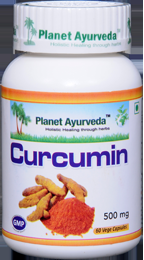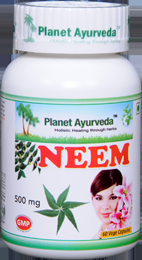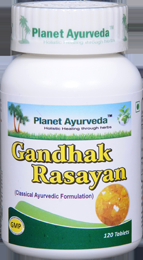Gangrene: Gangrene is a serious and possibly fatal condition, it needs immediate and proper treatment. There are six types of gangrene. If you take improper treatment or leave untreated, the only option is to remove the limb if the situation becomes more serious. But Ayurveda provides various herbs which are effective in the management of gangrene. In India, there are less than 1 million cases per year.
Gangrene is the condition that occurs due to the death of body tissues. It is induced by the lack of blood supply due to injury, illness and the presence of severe bacterial infection. It mainly occurs by a bacterial infection produced by bacterium clostridium perfringens. It affects the fingers, limbs, toes, and also occur in muscles and internal organs.
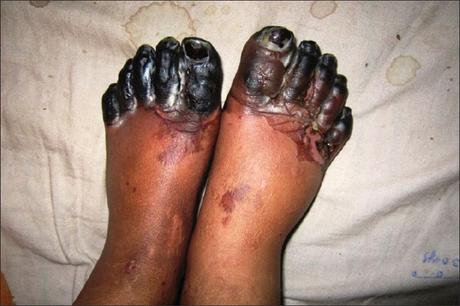
Types of Gangrene
1. Dry Gangrene
It develops slowly and predominantly in the patient suffering from diabetes or arterial blood vessel disease such as atherosclerosis. It is characterized by dry and wrinkled skin, which is brown to purple-blue or black.
2. Wet Gangrene
It develops when a bacterial infection in the injured tissue becomes the cause of gangrene. The common symptoms of wet gangrene are blistering, swelling, and wet conditions.
3. Gas Gangrene
The common cause of gas gangrene is infection due to bacterium Clostridium perfringens, which occurs in the wound or surgical cut that interferes with the blood supply. It affects deep muscle tissue.
4. Internal Gangrene
This type of gangrene which affect the internal organ of the body may be one or more than one such as gallbladder, intestines, or appendix, etc. It may create severe pain and fever. It can be fatal if left untreated.
5. Fournier's Gangrene
Fournier's gangrene affects genital organs. Usually, men are more prone to develop gangrene but Fournier's gangrene affects women more.
6. Meleney's Gangrene
This is a rare type of gangrene. It may occur after one or two weeks of surgery.
Risk Factors
There are several factors that increase the risk of generating gangrene which includes the following:
- Diabetes
- Severe injury
- Surgery
- Obesity
- Immunosuppressive disease (HIV infection)
- Smoking
Symptoms of Gangrene
The gangrene affects the skin and internal organs of the body, so it appears with different symptoms according to the site that affected.- Skin discoloration like yellow to black, blue, purple, bronze, and red.
- A clear edge between normal and damaged skin
- Severe and sudden pain.
- Numbness
- Foul-smelling secretion from the wound.
- Shiny thin skin or skin without hair
- Affects tissues underneath the skin
- Like in gas gangrene or internal gangrene.
- Pain and swelling in affected tissues.
- Low-grade fever.
- When the bacterial infection cause gangrenes in affected tissues and spreads throughout the body
- Hypotension
- Fever (temperature falls from the normal i.e. 96.8 F)
- Fast heart rate
- Lightheadedness
- Breathlessness
- Confusion or uncertainty
- Dizziness
Ayurvedic Aspect for Gangrene
In Ayurveda, there is no particular explanation of gangrene but according to Acharya Charaka (Kotha), gangrene means decayed and dead part, which is considered as complications of Vrana (1).
Herbal Remedies for Gangrene
Ayurveda is a holistic approach that helps to make a balance in the body, mind, and soul with the use of herbs and proper diet habits. Therefore Ayurveda is the new hope in this era as Ayurveda concentrates on the root of the disease and controls the symptoms without producing any adverse effects on the body. Although herbs take time to show their effect they have positive results on the body.
Some Herbs for Gangrene
- Neem
- Curcumin
- Gotukola
- Amla
- Neem: It possesses immunomodulatory, anti-hyperglycaemic, anti-inflammatory, antimalarial, antiulcer, antibacterial, antifungal, antiviral, antioxidant, and anticarcinogenic properties (2).
- Curcumin: It possesses anti-inflammatory, and antioxidant properties (3).
- Gotukola: It possesses anti-inflammatory, antioxidant, hepatoprotective and antidiabetic properties (4).
- Amla: It possesses various properties anti-atherogenic, anti-inflammatory, antioxidant, hypotensive, anti-mutagenic, and anti-carcinogenic, etc (5).
Herbal Products for Gangrene by Planet Ayurveda
Planet Ayurveda provides useful herbal medicines such as Neem Capsules, Curcumin Capsules, Gandhak Rasayan, Gotukola Capsules, and Navkarshik Churna to treat gangrene naturally. These herbal medicines are made by using the herbs of the best quality. These are 100 % natural, pure, and safe as these do not cause side effects.
1. Curcumin Capsules
2. Neem Capsules
3. Navkarshik Churna
4. Gandhak Rasayan
5. Gotukola Capsules
Product Description
1. Curcumin Capsules
Curcumin capsules are formulated by using a pure extract of Haridra (Curcuma longa). It contains anti-inflammatory and analgesic properties which help to reduce sore and wounds associated with Gangrene. It also possesses antimicrobial properties which make the body fight against the infections. It improves immunity and also forms new skin cells.
Dosage - Two capsules two times a day with plain water.
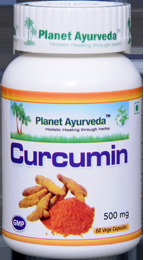

2. Neem Capsules
Neem capsules are made of adding a pure form of herb Neem (Azadirachta indica). This herb is very useful in the management of gangrenes. It possesses anti-inflammatory properties which help to reduce inflammation and pain. Its antiseptic properties improve the healing process, thus helps to heal the sores and wounds associated with gangrene.
Dosage - Two capsule two times a day with plain water.
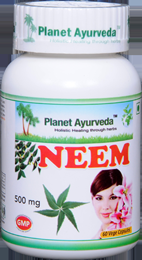

3. Navkarshik Churna
Navkarshikchurna is a wonderful combination of many herbs which are helpful to control gangrene. It includes Amla (Emblica Officinalis), Haritaki (Terminalia chebula), Vacha (Acorus calamus), Neem (Azadirachta indica), Bahera (Terminalia bellerica), Katuki (Picrorrhiza kurrao),Manjishta (Rubia cordifolia), Giloy (Tinopsora cordifolia), and Daruhaldi (Berberis aristata). These herbs help to purify the blood. It possesses anti-inflammatory and antimicrobial properties. Navkarshik Churna is very effective to provide relief in the symptoms associated with gangrene.
Dosage - 1 teaspoonful, two times a day post-meal with plain water.
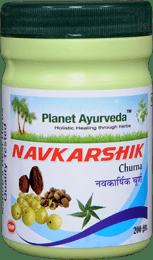

4. Gandhak Rasayan
Gandhak rasayan are effective tablets of Planet Ayurveda for gangrene. It contains a pure form of gandhak (purified Sulphur) which helps to control the indications associated with gangrene such as severe pain and swelling of tissues. It also improves the wound healing process in the patient of gangrene.
Dosage - 2 tablets two times a day post meals with plain water.
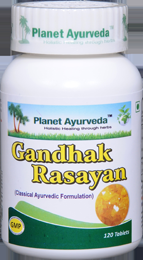
Gangrene: Gangrene is a serious and possibly fatal condition, it needs immediate and proper treatment. There are six types of gangrene. If you take improper treatment or leave untreated, the only option is to remove the limb if the situation becomes more serious. But Ayurveda provides various herbs which are effective in the management of gangrene. In India, there are less than 1 million cases per year.
Gangrene is the condition that occurs due to the death of body tissues. It is induced by the lack of blood supply due to injury, illness and the presence of severe bacterial infection. It mainly occurs by a bacterial infection produced by bacterium clostridium perfringens. It affects the fingers, limbs, toes, and also occur in muscles and internal organs.
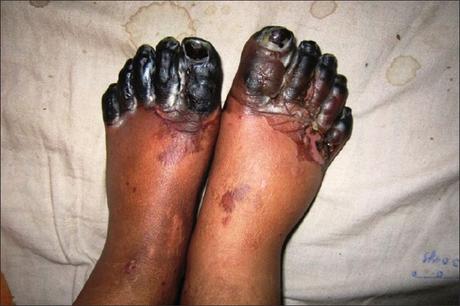
Types of Gangrene
1. Dry Gangrene
It develops slowly and predominantly in the patient suffering from diabetes or arterial blood vessel disease such as atherosclerosis. It is characterized by dry and wrinkled skin, which is brown to purple-blue or black.
2. Wet Gangrene
It develops when a bacterial infection in the injured tissue becomes the cause of gangrene. The common symptoms of wet gangrene are blistering, swelling, and wet conditions.
3. Gas Gangrene
The common cause of gas gangrene is infection due to bacterium Clostridium perfringens, which occurs in the wound or surgical cut that interferes with the blood supply. It affects deep muscle tissue.
4. Internal Gangrene
This type of gangrene which affect the internal organ of the body may be one or more than one such as gallbladder, intestines, or appendix, etc. It may create severe pain and fever. It can be fatal if left untreated.
5. Fournier's Gangrene
Fournier's gangrene affects genital organs. Usually, men are more prone to develop gangrene but Fournier's gangrene affects women more.
6. Meleney's Gangrene
This is a rare type of gangrene. It may occur after one or two weeks of surgery.
Risk Factors
There are several factors that increase the risk of generating gangrene which includes the following:
- Diabetes
- Severe injury
- Surgery
- Obesity
- Immunosuppressive disease (HIV infection)
- Smoking
Symptoms of Gangrene
The gangrene affects the skin and internal organs of the body, so it appears with different symptoms according to the site that affected.- Skin discoloration like yellow to black, blue, purple, bronze, and red.
- A clear edge between normal and damaged skin
- Severe and sudden pain.
- Numbness
- Foul-smelling secretion from the wound.
- Shiny thin skin or skin without hair
- Affects tissues underneath the skin
- Like in gas gangrene or internal gangrene.
- Pain and swelling in affected tissues.
- Low-grade fever.
- When the bacterial infection cause gangrenes in affected tissues and spreads throughout the body
- Hypotension
- Fever (temperature falls from the normal i.e. 96.8 F)
- Fast heart rate
- Lightheadedness
- Breathlessness
- Confusion or uncertainty
- Dizziness
Ayurvedic Aspect for Gangrene
In Ayurveda, there is no particular explanation of gangrene but according to Acharya Charaka (Kotha), gangrene means decayed and dead part, which is considered as complications of Vrana (1).
Herbal Remedies for Gangrene
Ayurveda is a holistic approach that helps to make a balance in the body, mind, and soul with the use of herbs and proper diet habits. Therefore Ayurveda is the new hope in this era as Ayurveda concentrates on the root of the disease and controls the symptoms without producing any adverse effects on the body. Although herbs take time to show their effect they have positive results on the body.
Some Herbs for Gangrene
- Neem
- Curcumin
- Gotukola
- Amla
- Neem: It possesses immunomodulatory, anti-hyperglycaemic, anti-inflammatory, antimalarial, antiulcer, antibacterial, antifungal, antiviral, antioxidant, and anticarcinogenic properties (2).
- Curcumin: It possesses anti-inflammatory, and antioxidant properties (3).
- Gotukola: It possesses anti-inflammatory, antioxidant, hepatoprotective and antidiabetic properties (4).
- Amla: It possesses various properties anti-atherogenic, anti-inflammatory, antioxidant, hypotensive, anti-mutagenic, and anti-carcinogenic, etc (5).
Herbal Products for Gangrene by Planet Ayurveda
Planet Ayurveda provides useful herbal medicines such as Neem Capsules, Curcumin Capsules, Gandhak Rasayan, Gotukola Capsules, and Navkarshik Churna to treat gangrene naturally. These herbal medicines are made by using the herbs of the best quality. These are 100 % natural, pure, and safe as these do not cause side effects.
1. Curcumin Capsules
2. Neem Capsules
3. Navkarshik Churna
4. Gandhak Rasayan
5. Gotukola Capsules
Product Description
1. Curcumin Capsules
Curcumin capsules are formulated by using a pure extract of Haridra (Curcuma longa). It contains anti-inflammatory and analgesic properties which help to reduce sore and wounds associated with Gangrene. It also possesses antimicrobial properties which make the body fight against the infections. It improves immunity and also forms new skin cells.
Dosage - Two capsules two times a day with plain water.
